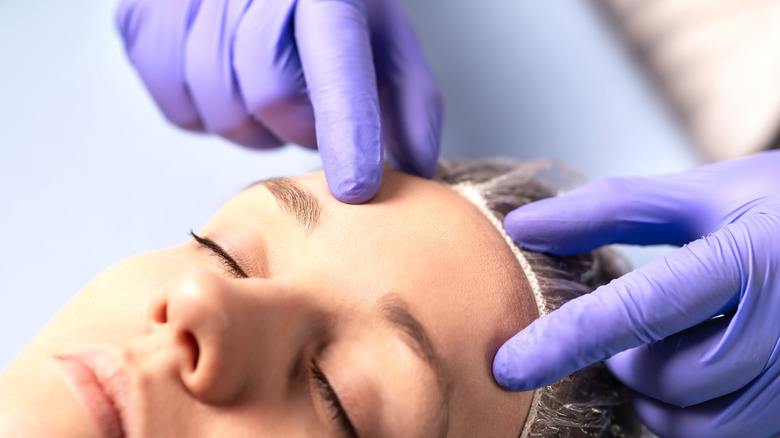What To Know About Forehead Reduction Surgery
Otherwise known as a hairline lowering procedure, forehead reduction surgery involves changing the placement of one's hairline by bringing it further down the forehead towards the eyes in order to minimize the overall size of the forehead (via AEDIT).
The surgery can benefit those wishing to change the cosmetic appearance of their hairline or transgender patients seeking gender-affirming surgeries. Here's what to know in regards to what takes place before, during, and after forehead reduction surgery.
According to experts at AEDIT, the surgery costs between $7,000 and $14,000. Prior to the procedure, patients will need to refrain from smoking starting four weeks before the surgery. Patients will also be required to stop the usage of any blood-thinning medications two weeks before the procedure. Alcohol consumption should be stopped two days beforehand and patients should not eat or drink anything for six or more hours prior to surgery.
Per Healthline, on the day of the procedure, your surgeon will mark areas for removal with a surgical skin marker before administering a local anesthetic to numb the region between your natural hairline and the tops of your eyebrows.
What to expect following forehead reduction surgery
Next, an incision will be made in close proximity to the hairline as well as along the forehead. Rather than a straight line, AEDIT notes that the incision will be made in a slightly jagged pattern in order to resemble a natural hairline.
After removing the designated section, your natural hairline incision will then be brought down to meet the forehead incision, thereby shortening the length of the forehead (via Healthline). Your surgeon will then use sutures to close the wound. Generally speaking, the procedure takes around three hours to complete, according to Northwestern Facial Plastic Surgery.
Following surgery, patients may experience bruising, swelling, itching, and general discomfort, notes AEDIT. Pain relief medication is often prescribed within the week following the procedure, and hair shedding is not uncommon during the first two to four weeks after surgery.
Additionally, AEDIT notes that scalp numbness may be experienced for as many as three months to a year after the fact, although regular hair growth can be observed after about three months. Patients are generally fully healed after 12 to 18 months.
Potential risks associated with the procedure include bleeding, infection, nerve damage, or scarring, notes Healthline. Furthermore, in a 2021 meta-analysis, researchers looked at side effects incurred after forehead reduction surgery in over 800 patients. Complications included the development of alopecia, hematoma, visible scarring, and ongoing paresthesia. However, collectively, the risk of forehead reduction surgery-related complications stood at 1% or less.


